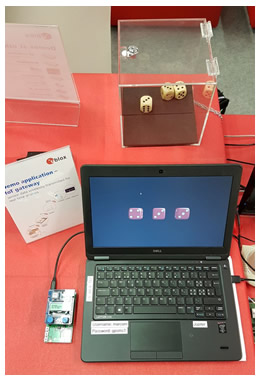Super low power GNSS receiver for portable applications
Last month at Mobile World Congress, in Barcelona u-blox was there to demonstrate its new super low power GNSS receiver for portable applications, UBX‑M8230‑CT, as well as LTE Cat 1 technology and WiFi and Bluetooth gateway connectivity.
First that was featured was the new UBX‑M8230‑CT, which is what the company describes as a ground‑breaking super low power GNSS receiver chip for wearable applications.
Recorded with a commercial product antenna, the demo showed the course of a person running, using two identical designs configured one with the 1Hz full power mode and the other with the 1Hz new Super‑E mode. The 2D accuracy and the power consumption of each configuration are then visually and quantitatively compared, thereby demonstrating the Super‑E mode’s balance between power and performance in the case of portable applications. 
The next demo showed video surveillance with bi‑directional data streams, providing a full end‑to‑end working demonstration of u‑blox’s own UBX‑R3 LTE Cat 1 modem technology platform within the LARA‑R3121 module. It is deployed in a representative use‑case example of a video surveillance monitoring and control application, which serves to show the benefits of LTE Cat 1 to support data rates suitable for video streaming in an M2M deployment.
u‑blox also demonstrated WiFi, Bluetooth, and Bluetooth low energy in an IoT architecture, The IoT Gateway Dice Demo consists of a number of dice with embedded NINA‑B1 Bluetooth low energy modules. They are connected to a local network via the IoT gateway module ODIN‑W2 and then onwards to the cloud. A web app pulls the reported sensor data into a page with a rendered image of a set of dice on the screen. The NINA‑B1’s powerful Cortex M4F application processor enables customers to develop reliable, secure low power sensor solutions for medical, telematics, control, home automation, point of sales applications, and more.
Guest blog courtesy of u-blox.






